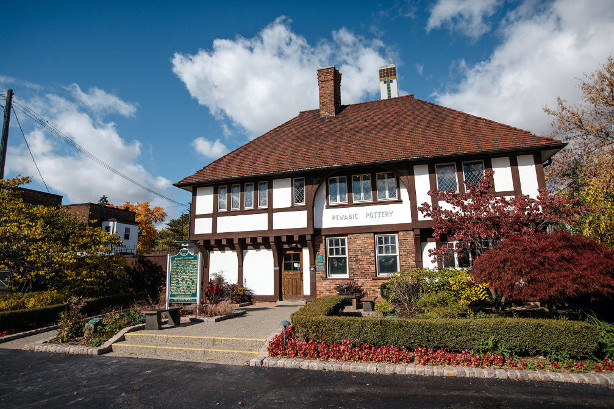Pewabic Pottery
Introduction
Pewabic Pottery is a ceramic studio and school at 10125 East Jefferson Avenue, Detroit, Michigan. Founded in 1903, the studio is known for its iridescent glazes, some of which grace notable buildings such as the Shedd Aquarium and Basilica of the National Shrine of the Immaculate Conception. The pottery continues in operation today, and was designated a National Historic Landmark in 1991.
History
The pottery was founded in 1903 by the artist and teacher Mary Chase Perry Stratton and Horace James Caulkins, her business partner. Caulkins was considered a high-heat and kiln specialist, and developed the "Revelation kiln". Mary Perry Stratton was "the artistic and marketing force." The collaboration of two and their blend of art and technology gave the pottery its distinctive qualities as Detroit's contribution to the International Arts and Crafts movement and exemplified the American Craftsman Style.
The word Pewabic is derived from the Ojibwa (or Chippewa) word "wabic", which means metal, or "bewabic", which means iron or steel, and specifically referring to the "Pewabic" Upper Peninsula copper mine where Ms. Stratton walked with her father. The company is well known for the unusual iridescent glaze covering the pottery and tiles created in a manner outlined by the International Arts and Crafts movement.
In 1991, Pewabic Pottery was designated as a National Historic Landmark. See also, List of National Historic Landmarks in Michigan. As Michigan's only historic pottery, the center continues to operate in a 1907 Tudor Revival building as a non-profit educational institution. They offer classes in ceramics, hold exhibitions, sell pottery made in house, showcase and sell artists from across the United States, and offer design and fabrication services for public and private buildings.
Museum and Galleries
The museum's exhibits focus on the company's role in the history of Detroit, the Arts and Crafts movement in America and the development of ceramic art in the country. The galleries also showcase new works by modern ceramic artists.
Famous Works
Pewabic Pottery produces many kinds of hand made decorative objects. They are part of the collections of the Detroit Institute of Arts and the Freer Gallery of Art.
Under Mary Stratton's artistic leadership, Pewabic Pottery employees created lamps, vessels, and architectural tiles. Architectural pieces have been a staple in Pewabic's history. They were known for their iridescent (like an oil slick with an incredible translucent quality and a phantasmagoric depth of color) glazes. Architectural tiles were used in churches, concert halls, fountains, libraries, museums, schools and public buildings. The studio's work graces numerous edifices throughout Michigan and the rest of the United States. Noteworthy examples include Herzstein Hall at Rice University in Houston, Texas, and the Shedd Aquarium in Chicago. Illinois.
Particularly notable was the company's work at the Basilica of the National Shrine of the Immaculate Conception in Washington, D.C., consisting of arches outlined with iridescent Pewabic tile, huge ceramic medallions set in the ceiling, and fourteen Stations of the Cross for the crypt.
Pewabic's design team continues to create ornate tile conceptions for public and private buildings. Contemporary installations include Comerica Park, home of the Detroit Tigers, Detroit Medical Center Children's Hospital, five Detroit People Mover stations, Third Man Records (Detroit), stations for the Q-Line, and the Herald Square in New York City.
